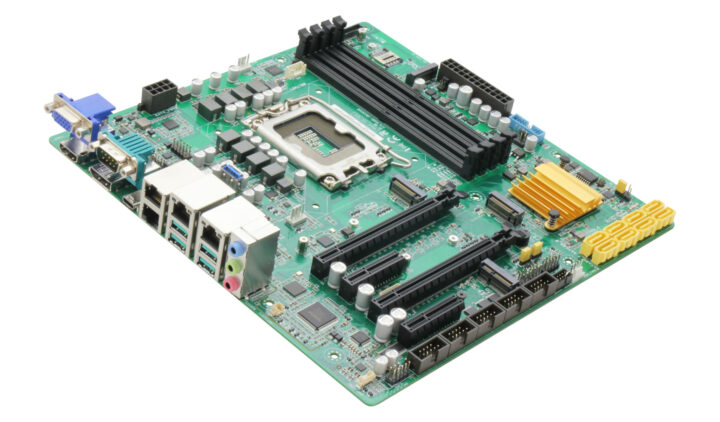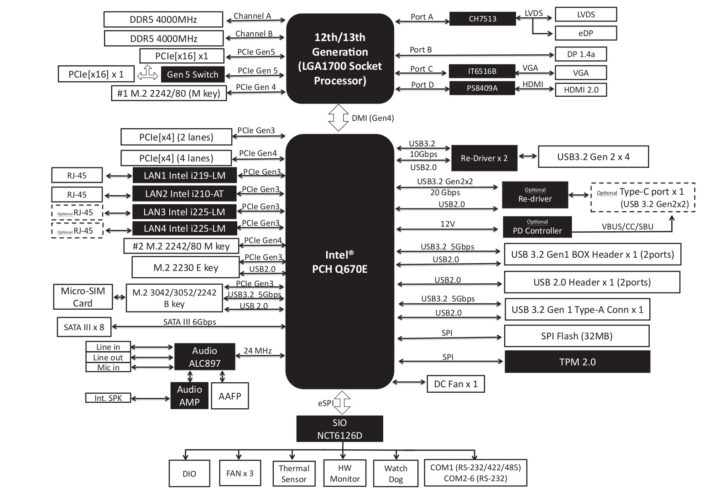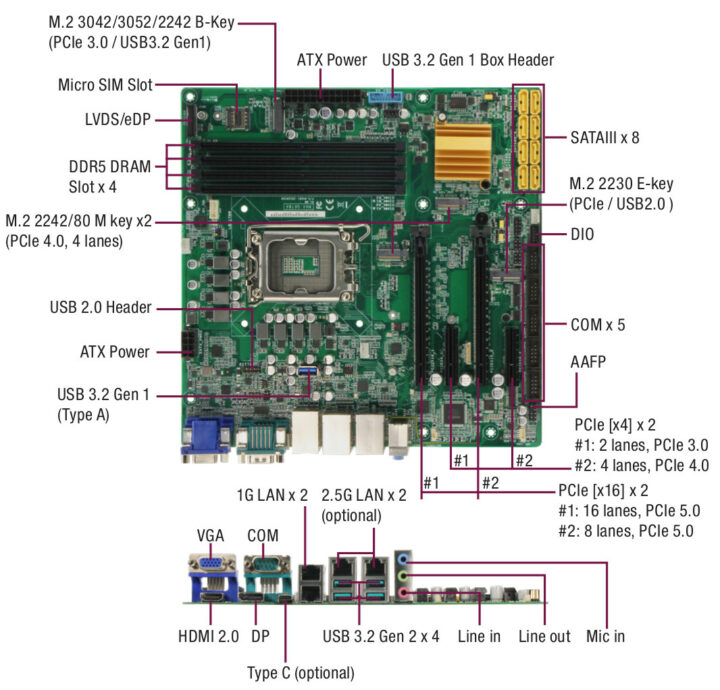AAEON MAX-Q670A is an industrial micro-ATX motherboard that accepts socketed 13th Gen Intel Core Raptor Lake processors, supports up to 128GB DDR5, offers eight SATA ports with RAID 0/1/5/10, up to four Ethernet ports (GbE and 2.5GbE), and two 16-lane PCIe Gen 5 slots.
Other features include five display interfaces with HDMI, DisplayPort, VGA, LVDS, and eDP, four bootable USB 3.2 Gen 2 Type-A ports, an RS232/RS422/RS485 COM port, and plenty of internals headers for more serial and USB ports, as well as M.2 expansion sockets and a digital I/O port

AAEON MAX-Q670A specifications:
- SoC – 12th/13th Generation Intel Core LGA1700 Socket processors (Alder Lake or Raptor Lake) with up to 125W TDP
- Chipset – Intel Q670 Express Chipset
- I/O Chipset – NCT6126D
- System Memory – Up to 128GB via 4x DIMM slots for DDR5 4,000MHz non-ECC, un-buffered memory
- Storage
- 8x SATA III ports with support for RAID 0, 1, 5, 10
- 2x M.2 2242/2280 M-Key sockets (PCIe Gen 4.0, 4 lanes, supports RAID 0, 1, 5, 10)
- 256 Mbit flash for AMI BIOS/UEFI with Wake-on-LAN/PXE support
- Display interfaces
- HDMI 2.0 up to 4096 x 2160 @ 60/30 Hz with digital audio
- DisplayPort 1.4 up to 4096 x 2160 @ 24 Hz or 3840 x 2160 @ 60 Hz with digital audio
- VGA up to 1920 x 1200 @ 60Hz (via IT6516B)
- 18/24-bit dual-channel LVDS up to 1920 x 1080 @ 60 Hz
- eDP up to 3840 x 2160 @ 30 Hz
- Backlight control
- Audio
- Realtek ALC897 6-Channel High Definition Audio CODEC
- 3x audio jacks: Line-in, Mic-in, Line-out
- Speaker header (Line-out), 1x AAFP analog audio front panel
- Networking
- Gigabit Ethernet RJ45 LAN port via Intel PHY I219-LM with support for Intel AMT 12.0
- Gigabit Ethernet RJ45 LAN port via Intel I210-AT controller
- Optional 2x 2.5GbE LAN ports via two Intel I225-LM controllers
- USB
- 4x USB 3.2 Gen 2 ports (10Gbps)
- Optional USB Type-C port up to 20Gbps, 5V/3A
- Note: All external USB ports are bootable and can be deactivated per BIOS function; USB Power switchable feature
- Internal USB interfaces
- 2x USB 3.2 Gen 1 via 2x 2.54mm pitch box headers
- 2x USB 2.0 via 2x 5-pin 2.54mm pitch box headers
- Internal USB 3.2 Gen 1 vertical Type-A port
- Serial
- DB9 COM port with support for RS-232/422/485, 5V/12V/RI
- 5x RS-232 via 9-pin headers
- Expansion Slot
- PCIe Gen 5 [x16] slot (8 Lanes/8 Lanes when dual-use PCIe [x16] slot)
- PCIe Gen 3 [x4] slot (2 Lanes, Open Slot)
- PCIe Gen 5 [x16] slot (8 Lanes)
- PCIe Gen 4 [x4] slot (4 Lanes)
- M.2 3042/3052/2242 B-Key socket (PCIe 3.0 [x1]/USB 3.2 Gen 1) + Micro SIM slot
- M.2 2230 E-Key socket (PCIe 3.0 [x1]/USB 2.0)
- 8-bit digital I/O interface
- Security – TPM 2.0 onboard
- Misc
- H/W Monitor – Temperature Monitor on CPU/Chassis, Voltage Monitor on Vcore/5V/3.3V/12V, Fan Monitor on CPU/Chassis
- Watchdog Timer
- Smart Fan Control
- 4-pin CPU fan connector (PWM Mode)
- 2x 4-pin chassis fan connectors (PWM Mode)
- 3-pin chassis fan connector (DC Mode)
- Power State – S3, S4, S5
- Chassis intrusion
- AT/ATX mode select jumper
- Front panel header
- Clear CMOS jumper
- Onboard buzzer
- 3-pin ME lock header
- LED header for 2x or 4x Ethernet ports
- Power Supply – 24-pin ATX connector, 8-pin ATX 12V power connector
- Dimensions – 244 x 244mm (Micro-ATX form factor)
- Weight – 800 grams
- Temperature Range – Operating: 0°C ~ 60°C, storage: -40°C ~85°C
- Humidity – 0% ~ 90% relative humidity, non-condensing
- Certifications – CE & FCC Class A
- MTBF – 267,950 hours
The company only provides drivers for Windows 10 64-bit and Windows 11 64-bit, so Linux does not seem to be officially supported. We are not told which industrial applications would benefit from the micro-ATX Raptor Lake motherboard, but that would be solutions that require lots of SATA storage with redundancy, multiple video interfaces, high-speed PCIe Gen 5 expansion cards, and plenty of serial ports, as well as the high-processing power delivered by the Intel Alder Lake or Raptor Lake processors combined with a lot of RAM (up to 128GB) to handle the workload(s).

Further information may be found on the product page and press release.

Jean-Luc started CNX Software in 2010 as a part-time endeavor, before quitting his job as a software engineering manager, and starting to write daily news, and reviews full time later in 2011.
Support CNX Software! Donate via cryptocurrencies, become a Patron on Patreon, or purchase goods on Amazon or Aliexpress





